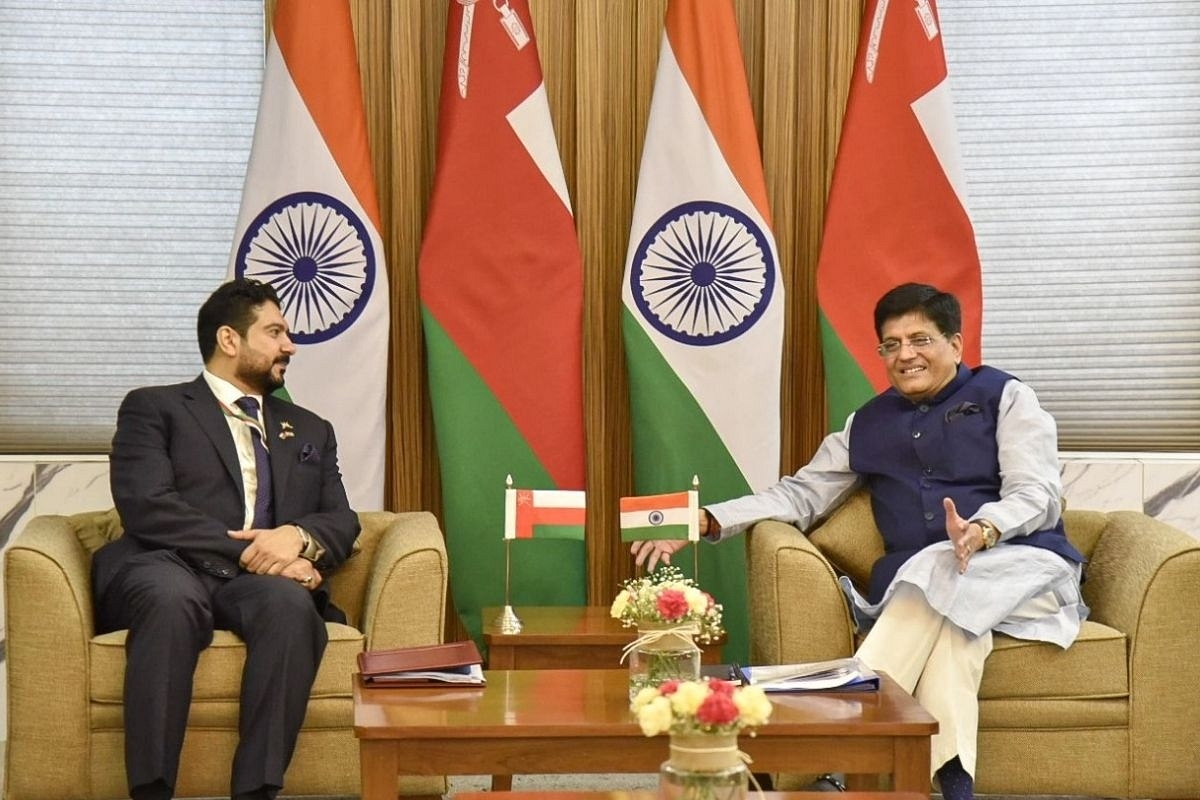Business
India, Oman To Facilitate Trade, Address Tariff And Non-Tariff Barriers Amid PTA Buzz
- Commerce Minister Piyush Goyal addressed the India-Oman Joint Business Council meeting today.
- As India and Oman firm up the trade relationship, there are major opportunities lined up for Indian companies, for instance in Oman’s SOHAR Port and Freezone where Indian companies have emerged as leading investors.

Qais bin Mohammed al Yousef and Piyush Goyal
Following the operationalisation of the India-UAE free trade agreements on 1 May 2022 and amid growing buzz over India and Oman exploring a preferential trade agreement (PTA), the tenth session of the India-Oman Joint Commission Meeting (JCM) held on Wednesday (11 May) saw India and Oman covering significant ground aimed at lifting the entire gamut of bilateral economic relations to a higher trajectory. Commerce Minister addressed the India-Oman Joint Business Council meeting on Thursday (12 May).
From the PTA angle the visit is important as Oman besides being a strategic partner of India, is also an important interlocutor at the Gulf Cooperation Council (GCC) with which India is also pursuing an FTA. This underlines the visit of Minister of Commerce, Industry and Investment Promotion of the Sultanate of Oman Qais bin Mohammed al Yousef to India -- with a strong multi-sectoral 48-member delegation -- to attend the meeting which was also co-chaired by Minister of Commerce and Industry Piyush Goyal.
The ninth session of the India-Oman JCM was held on 19 October 2020 through virtual platform and identified food security, space cooperation, pharmaceuticals, minerals and mining as new areas for cooperation which will add deeper layers to the relations going ahead.
The presence of Omani businesses from health, pharmaceuticals, mining, tourism, telecommunication, energy, shipping and real estate in the delegation highlights the Omani area of interests and will be an opportunity for India and Oman to diversify the trade basket.
With a robust growth in bilateral trade from $5.4 billion in 2020-21 to $9.94 billion during 2021-2022, supported by an annual growth of 82.6 per cent, the two countries have travelled far to become important trading partners for each other. India’s exports to Oman in FY 2019-20 was $2,261.81 million and imports from Oman in the same fiscal year was $3,669.33 million.
Moreover, Indian firms have invested heavily in Oman in various sectors like iron and steel, cement, fertilisers, textile, cables, chemicals and automotive, represented by over 6,000 enterprises and establishments in the country with an estimated investment of $7.5 billion. Cumulative FDI equity inflows from Oman to India during the period April 2000-December 2021 have amounted to $558.68 million.
The visit also comes amidst the Russia-Ukraine crisis which has disrupted fuel supplies and could be leveraged by India to boost its energy security. The rise in crude prices impacts Indian as it imports around 85 per cent of its energy requirements. The Indian basket of crude comprising Oman, Dubai and Brent crude, was last recorded at $103.29 per barrel on 10 May.
Petroleum oils and oils obtained from bituminous minerals crude and liquefied natural gas are among main items of India’s imports from Oman. India was the third largest market for Oman’s crude oil exports for the year 2019 after China and Japan. Oman’s oil exports to India jumped by 44.4 per cent to more than 12 million barrels in the first three months of this year from 8.3 million barrels in the same period of 2021, according to sources.
Also on the cards is Rupay card acceptance in Oman. As an important step in market access, India and Oman have agreed that Muscat will fast track approvals for registration of Indian pharmaceutical products already registered by the United States Food and Drug Administration (USFDA), Britain’s United Medicines and Healthcare products Regulatory Agency (UKMHRA) and EMA.
A market research report on pharmaceutical sector in Oman and released at the JCM highlights strategies and opportunities for Indian companies in Oman in this sector.
The FTA could embrace collaboration across a range of fields that came up at the JCM with particular emphasis on the 3Ts -- trade, technology, tourism -- food and agriculture, renewable energy including green hydrogen and green ammonia, health and pharmaceuticals, mining and manufacturing.
Already, as part of the Ministry of Commerce and Industry’s efforts to explore and diversify new markets, Oman has emerged as a prominent importing country for maize while India’s exports of fresh fruits to Oman was $22.31 million in 2020-21 and that of dairy products was $7.46 million.
As India and Oman firm up the trade relationship, there are major opportunities lined up for Indian companies, for instance in Oman’s SOHAR Port and Freezone where Indian companies have emerged as leading investors.
SOHAR Port offers to Indian metal producers various advantages and prospects in downstream metal operations like reliable and affordable energy including solar, anchor businesses for access to raw materials, on-site consumers of metals and mature port infrastructure. Global industry leaders such as Jindal Steel and Power, Vale and Al Tamman Indsil have successfully utilised the value propositions of SOHAR Port and Freezone.
Introducing ElectionsHQ + 50 Ground Reports Project
The 2024 elections might seem easy to guess, but there are some important questions that shouldn't be missed.
Do freebies still sway voters? Do people prioritise infrastructure when voting? How will Punjab vote?
The answers to these questions provide great insights into where we, as a country, are headed in the years to come.
Swarajya is starting a project with an aim to do 50 solid ground stories and a smart commentary service on WhatsApp, a one-of-a-kind. We'd love your support during this election season.
Click below to contribute.
Latest